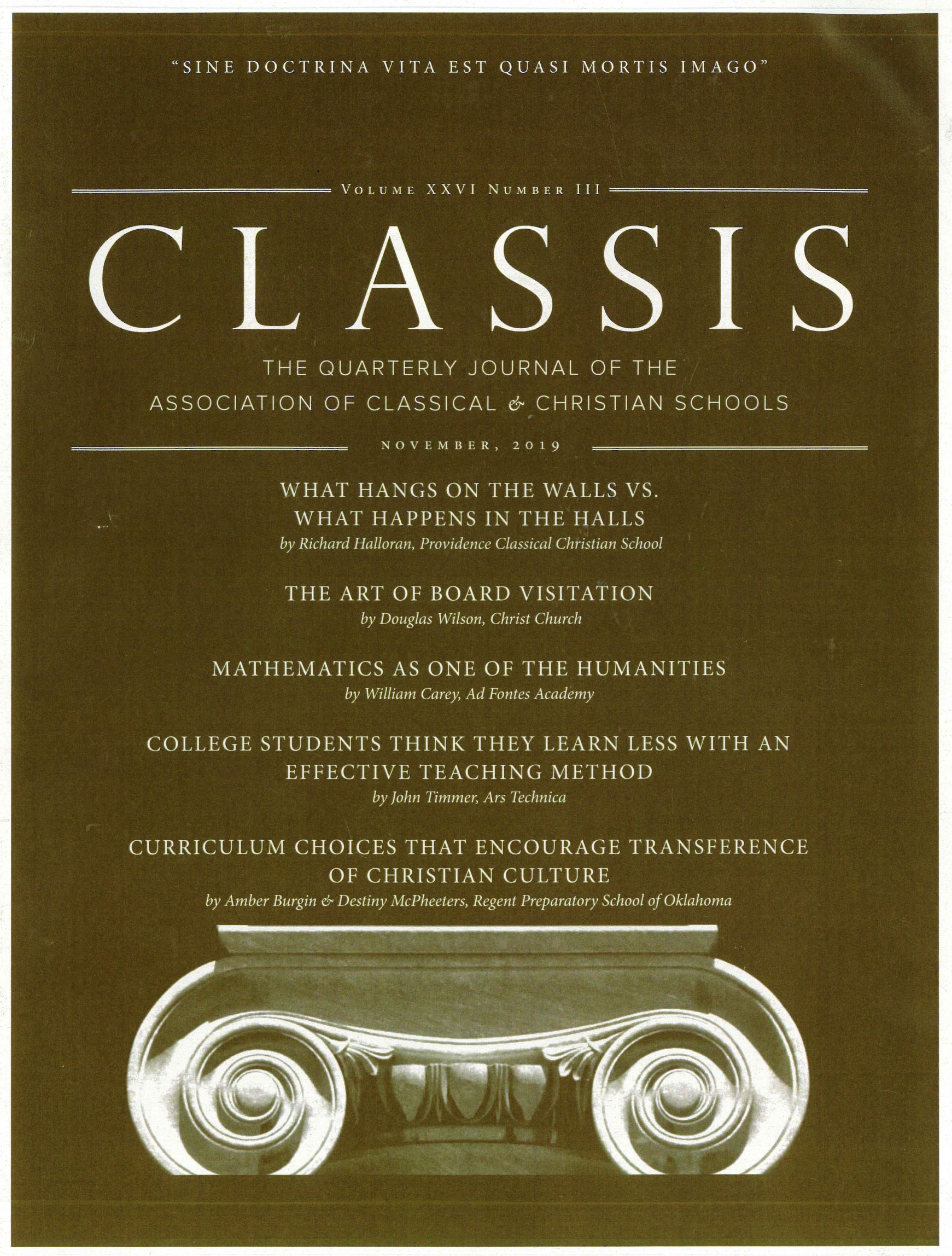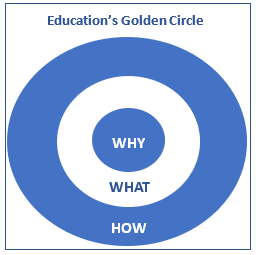What Hangs on the Wall vs.
What Happens in the Halls
by Richard Halloran
The following article appeared in the Classis: The Quarterly Journal of the Association of Classical & Christian Schools, Volume 26, November 2019. Published quarterly, this journal is for educators and thinkers who want to delve into the details and understand classical Christian education on a deeper level.
Over a decade ago, while attending a pastoral ministry conference, I heard Andy Stanley make a statement that has stuck with me ever since. While discussing the importance of organizational systems, he made the point that what happens in the hall (the day-to-day actual life of a ministry) is more important than what’s hanging on the wall (a ministry’s mission statement). Such terminology also resonates with the life of a school.
Almost every school has a mission statement, designed to explain why the school exists. Mission statements can be actual, reflecting that the school community owns and lives out the mission daily. Sometimes, however, what happens in the halls reflects that the mission statement is more aspirational than actual. It simply reflects what the school aspires to be rather than what actually happens in the classrooms and in the school community. As classical Christian schools, we do well to remember that “the proof is in the pudding,” not the wording of a statement.
This does not mean that mission statements are irrelevant. In fact, the opposite is true. A clear mission statement is foundational for a school. Simon Sinek’s concept of the golden circle is valuable in understanding this. Great organizations work from the inside out, from the why to the how to the what. However, for schools, I would suggest that the what is more central than the how because our product is not a computer or a movie but people. Our what attempts to paint a picture of what the mission looks like fulfilled. It is our vision for who our ideal graduates are becoming and how they are compelled to influence the world. The mission statement is critical because the circle finds its center with the why, explaining the purpose of the school. As Sinek rightly points out, “People are inspired by the why.”
A school’s mission statement is what distinguishes it from other schools. As Christian schools, our mission statements should be rooted in Christ’s commission to make disciples. We exist to daily be a part of God’s plan to reach the world! As classical schools, our methodology distinguishes us from others. While we must be careful not to allow this to lead us to exalt ourselves arrogantly above other schools, we must also boldly allow our mission to distinguish us from other schools: being classical is what makes us distinctive. Our schools are filled with a community of people who are committed to fulfilling a specific mission.
Since a mission statement is the guiding statement for all that the school does, it is important to craft it well. Since the goal is for the entire community to internalize the mission, it must be marketable and memorable. It must pass the “people test.” If people do not understand it, it is not clear. If people cannot remember it and quote it, it is not memorable. ISM (Independent School Management) recommends that a school keep its mission statement under thirty words. Personally, I find keeping a mission statement around twenty words to be more manageable, memorable, and marketable.
Why should a mission statement be marketable and memorable? The mission and vision of classical Christian education is lofty and requires hard work to fulfill. In order for the mission to become a reality, all parts of the community have to be committed to striving toward the same goals. This includes school boards, administrations, faculty, staff, students, and parents. The mission statement becomes the primary means to unite the community, serving as a clear guide that leads us, a reminder that keeps us focused, and an inspiration that motivates us to be unmovable and outstanding in our work for the Lord.
While a school’s mission statement must be value-laden, reflecting both a Christian and classical commitment, the statement is inherently broad. It has to be broad enough to summarize all that the school does, but it is not intended to be comprehensive. It is impossible to be comprehensive in twenty words. Furthermore, it is highly unlikely that a comprehensive mission statement is marketable and memorable.
Consider the following sample from our school: “Providence Classical School is a Christian school using the classical model to train students to impact their culture for Christ.” This mission statement was created by our founders long before I arrived, so I take no credit for its clarity, conciseness, and marketability. The statement is broad enough to encompass all aspects of what we do. It is value-laden in that it clarifies that we are a Christian school, while also distinguishing us by our commitment to using the classical model. It is connected to the Great Commission in that it highlights that our purpose is to train students who will then replicate the growth they’ve experienced in the world. It is not comprehensive, but it provides a platform to be more fully explained every time it is shared with the community.
So how does a school make sure there is not a discrepancy between “what is hanging on the wall” and “what happens in the halls”? Here are a handful of suggestions that I have found successful:
- Recognize God’s sovereignty and man’s responsibility. The school’s community, including its students, has the responsibility to own and live out the mission. Leaders in schools have the responsibility of inspiring others to share the mission. Yet, our labors will never accomplish the work of God without the empowerment of the Spirit of God. We do well to apply Saint Benedict’s principle of ora et labora (pray and work).
- Take every opportunity to communicate the mission, internally and externally. Your community needs to consistently hear the mission. Such communication will not only educate but will inspire. Prospective families need to hear the mission clearly explained and know its importance in the life of the school. If they are joining the school, they will become a part of the mission’s fulfillment.
- Remember that people are your most important key to carrying out your mission. Not only is your what focused on people (i.e., our students), but a key component of your how is also people, the faculty and staff. Your faculty are the biggest influence on whether or not your students have excellent classical Christian learning experiences. As one of my mentors once told me, “People are more important than the process.”
- Recognize that systems help create behaviors that either facilitate or impede the fulfillment of your mission. Systems are an essential component of your how. While we shepherd the hearts of students recognizing that behaviors flow from the heart, we must also recognize that the systems our school creates and implements impact the behaviors of faculty, staff, students, and the community. Every teacher recognizes that clear and consistent implementation of classroom systems goes a long way in managing a classroom. Consider whether or not your school’s systems facilitate or impede your mission.
- Take the time to learn from others who fulfill their mission well. Certainly, ACCS is a good starting point and offers resources to help. Visit other schools that model mission fulfillment also. Additionally, consider other types of organizations who are known for creating systems and cultures that enable mission fulfillment.
ACCS has used John Milton’s challenge to “repair the ruins” caused by our fallen world as a charge to classical Christian schools. While the decline of the modern educational system can be discouraging, classical Christian education provides a solution to Milton’s challenge by providing students with the tools for a lifetime of learning and training students who are capable of entering the world to repair the ruins. This is an exciting time to be part of a mission that has never been more important. Let’s make sure we are clear and unwavering in our reason for existence, making certain our mission statements are not merely aspirational but are actually lived out on a daily basis in the life of our schools.
Click here to read more about classical education from Head of School Richard Halloran.










